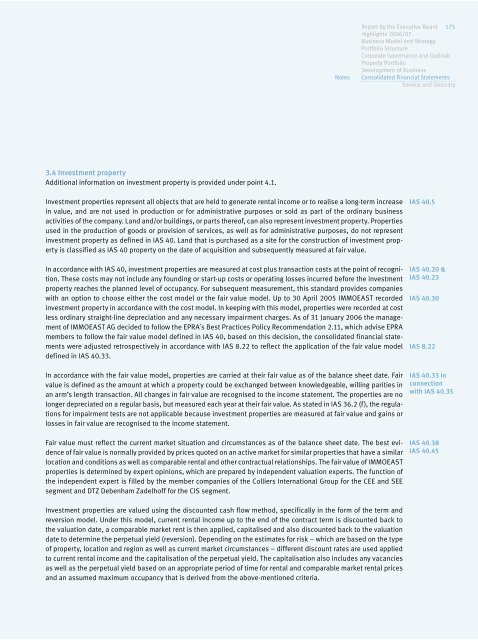IMMOEAST Annual Report 2006/07
IMMOEAST Annual Report 2006/07
IMMOEAST Annual Report 2006/07
You also want an ePaper? Increase the reach of your titles
YUMPU automatically turns print PDFs into web optimized ePapers that Google loves.
3.4 Investment property<br />
Additional information on investment property is provided under point 4.1.<br />
Investment properties represent all objects that are held to generate rental income or to realise a long-term increase<br />
in value, and are not used in production or for administrative purposes or sold as part of the ordinary business<br />
activities of the company. Land and/or buildings, or parts thereof, can also represent investment property. Properties<br />
used in the production of goods or provision of services, as well as for administrative purposes, do not represent<br />
investment property as defined in IAS 40. Land that is purchased as a site for the construction of investment property<br />
is classified as IAS 40 property on the date of acquisition and subsequently measured at fair value.<br />
In accordance with IAS 40, investment properties are measured at cost plus transaction costs at the point of recognition.<br />
These costs may not include any founding or start-up costs or operating losses incurred before the investment<br />
property reaches the planned level of occupancy. For subsequent measurement, this standard provides companies<br />
with an option to choose either the cost model or the fair value model. Up to 30 April 2005 <strong>IMMOEAST</strong> recorded<br />
investment property in accordance with the cost model. In keeping with this model, properties were recorded at cost<br />
less ordinary straight-line depreciation and any necessary impairment charges. As of 31 January <strong>2006</strong> the management<br />
of <strong>IMMOEAST</strong> AG decided to follow the EPRA´s Best Practices Policy Recommendation 2.11, which advise EPRA<br />
members to follow the fair value model defined in IAS 40, based on this decision, the consolidated financial statements<br />
were adjusted retrospectively in accordance with IAS 8.22 to reflect the application of the fair value model<br />
defined in IAS 40.33.<br />
In accordance with the fair value model, properties are carried at their fair value as of the balance sheet date. Fair<br />
value is defined as the amount at which a property could be exchanged between knowledgeable, willing parities in<br />
an arm’s length transaction. All changes in fair value are recognised to the income statement. The properties are no<br />
longer depreciated on a regular basis, but measured each year at their fair value. As stated in IAS 36.2 (f), the regulations<br />
for impairment tests are not applicable because investment properties are measured at fair value and gains or<br />
losses in fair value are recognised to the income statement.<br />
Fair value must reflect the current market situation and circumstances as of the balance sheet date. The best evidence<br />
of fair value is normally provided by prices quoted on an active market for similar properties that have a similar<br />
location and conditions as well as comparable rental and other contractual relationships. The fair value of <strong>IMMOEAST</strong><br />
properties is determined by expert opinions, which are prepared by independent valuation experts. The function of<br />
the independent expert is filled by the member companies of the Colliers International Group for the CEE and SEE<br />
segment and DTZ Debenham Zadelhoff for the CIS segment.<br />
Investment properties are valued using the discounted cash flow method, specifically in the form of the term and<br />
reversion model. Under this model, current rental income up to the end of the contract term is discounted back to<br />
the valuation date, a comparable market rent is then applied, capitalised and also discounted back to the valuation<br />
date to determine the perpetual yield (reversion). Depending on the estimates for risk – which are based on the type<br />
of property, location and region as well as current market circumstances – different discount rates are used applied<br />
to current rental income and the capitalisation of the perpetual yield. The capitalisation also includes any vacancies<br />
as well as the perpetual yield based on an appropriate period of time for rental and comparable market rental prices<br />
and an assumed maximum occupancy that is derived from the above-mentioned criteria.<br />
Notes<br />
<strong>Report</strong> by the Executive Board 175<br />
Highlights <strong>2006</strong>/<strong>07</strong><br />
Business Model and Strategy<br />
Portfolio Structure<br />
Corporate Governance and Outlook<br />
Property Portfolio<br />
Development of Business<br />
Consolidated Financial Statements<br />
Service and Glossary<br />
IAS 40.5<br />
IAS 40.20 &<br />
IAS 40.23<br />
IAS 40.30<br />
IAS 8.22<br />
IAS 40.33 in<br />
connection<br />
with IAS 40.35<br />
IAS 40.38<br />
IAS 40.45


